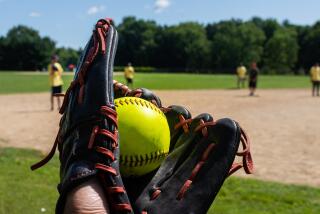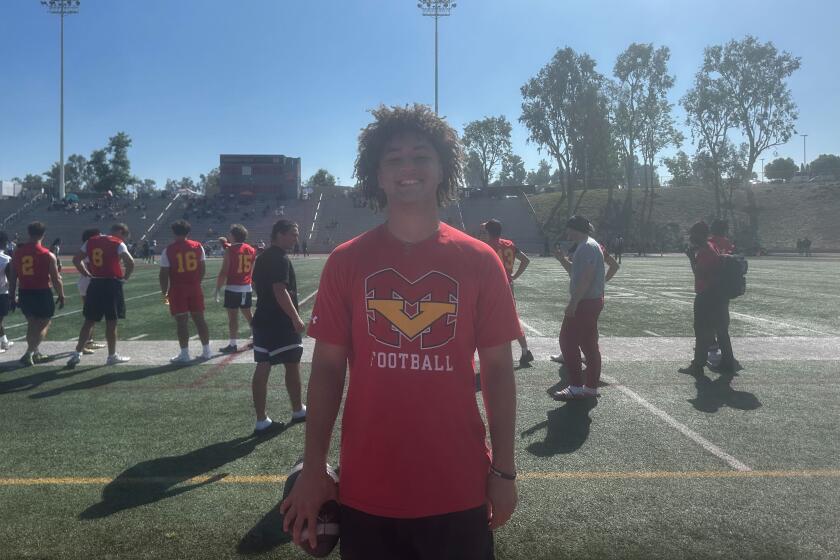Schools Are Back in Good Spirits : Cheering and Rooting for School Teams Are Cool Again After a 20-Year Decline
- Share via
A 10-year reunion dinner of Newbury Park High students from the class of 1975 was sparsely attended. And exactly eight alumni made it to nearby Borchard Park the next day for what was supposed to be a reunion picnic.
Dan Miller, a former varsity football player who traveled from San Luis Obispo for the reunion, was philosophical about the turnout.
“It’s only fitting,” he said. “Our class had zero school spirit.”
That’s all changed, according to current Newbury Park players.
“There is a lot of spirit at Newbury Park High,” said Robert Yoos, a senior defensive end for the Panthers. “The team gets great backing at rallies. Ten years down the road, we’ll remember how much spirit the school had.”
Added Bill Phillips, a senior running back: “I like our school spirit. It’s important not only for the school itself but for the morale of players.”
Several coaches and players agree that school spirit, like patriotism, is enjoying a revival.
“There is a great deal of pride for your school that didn’t exist eight to 10 years ago,” Canyon football Coach Harry Welch said.
After peaking in the late 1950s, school spirit all but disappeared in the ‘60s, and the flames of rebellion that died out by the early ‘70s were replaced by the icy earnestness of the Me Decade.
Yet school spirit still seemed silly. Then came the 1984 Olympics and rooting has been in vogue since. An auto ad proclaims, “The pride is back.” Beer is “made the American way.”
And, perhaps not coincidentally, it’s cool to root for your school.
“The national attitude and school spirit are tied in together,” said Darryl Stroh, football and baseball coach at Granada Hills. “Kids are less anti. You can kind of sense these things. The overall attitude toward Granada Hills High by students is on the upswing. But who knows if it is just a fad?”
Said Cleveland football Coach Steve Landress: “In the ‘70s long hair was in. Kids did their own thing and didn’t yell with the group. Now short hair is in. Guys look like Rambo even if they play football like Mary Sue.”
Marcus Felson, a USC sociology professor and the editor of the journal of Sociology and Social Research, believes the New Patriotism is nothing more than Madison Avenue marketing strategy and another passing craze.
“There is no tangible evidence of greater patriotism,” Felson said. “It’s all images. I’m suspicious of any claim of real social change.”
Spirit tends to be greater at schools with winning athletic programs. “We have good spirit but watch it fly out the window if we lose three games,” Stroh said.
Common to both winning and losing schools are dads who wear their sons’ football jerseys and bands delivering off-key renditions of “Proud Mary.”
And school spirit takes a different form at public schools than at private schools. Public schools generally garner more community support, while private schools use athletics to unify students who may live a long way from campus.
In general, a larger percentage of students at private schools participate in non-academic activities than at public schools.
“We have greater alumni support than most public schools,” said Paul Muff, athletic director and basketball coach at Crespi, a private school in Encino. “Grads stay loyal to the school. However, we don’t have the community support of, say, a Hart High. We don’t draw people from the neighborhood to games.”
Southern Section public schools enjoy the most neighborhood support, coaches say. Several City Section schools have lost a sense of community because many students are bused from other parts of Los Angeles.
“The bottom line on school spirit is if kids consider a school to be their school,” Kennedy football Coach Bob Francola said. “Where students shop for a school, spirit is on the decline.”
Still, the wave of school spirit has hit many City Section schools--Kennedy included.
“Our school has a tremendous amount of spirit,” Francola said. “I get asked in PE classes to run down a game. I know it exists.”
Eighteenth-century English essayist Samuel Johnson described patriotism as “the last
refuge of a scoundrel.”
School administrators might use scoundrel to describe students who deface the property of rival schools or start fights at events in the name of spirit. Kevin Rooney, athletic director and football coach at Notre Dame, has a solution.
“When I first came to Notre Dame, we had a serious hate-type rivalry with Crespi,” he said. “Kids were constantly breaking stuff and painting things at the other school.
“At a basketball game against Crespi last year, some of our kids threw Super Balls on the gym floor and we made them serve detention--at Crespi. Rather than just a punishment, it’s almost a humorous thing. We still have a rivalry, but now it’s based on competition rather than hatred.”
Sportsmanship is crucial in high school athletics, coaches say. Without it, there is a danger that as school spirit increases, tolerance and empathy may decrease.
“Rooting for your school is a form of chauvinism,” said Felson, the USC professor. “Usually, however, there is decency in how you do your rooting.”
Felson said research shows that teen-agers are spending less time at home. He sees a link to the increase in school spirit.
“More time is being spent away from adults,” he said. “Family time is on the decline and schools are the beneficiary of a lot of that time.”
Rooney agreed, saying: “It’s amazing how much time kids spend here. The school is the focus of everything they do.”
Because teen-agers spend comparatively little time at home, the recent splash of patriotism in advertising may not influence them as much as it does adults.
“Sure, advertising has picked up on patriotic images,” Felson said. “But teen-agers watch less TV than other age groups because they are more active. It’s their parents who get fired up.”
Muff often observes parents becoming infected with school spirit.
“It brings a lot of parents out,” he said. “After five days of work, Friday night football is the best time of their week. At Crespi, some parents live for that Friday night game.”
Parents of players were about the only Thousand Oaks rooters who traveled to Canyon last Friday night to watch Thousand Oaks attempt to snap Canyon’s 40-game winning streak. The Lancers were ranked No. 3 in the Valley area by The Times and, before the game, linebacker Gus Nelinger said: “Our school spirit is second to none.”
Only a few students made the drive to Canyon Country, however. Apparently, school spirit has a radius of less than 40 miles.
Players and coaches like to believe that most students attend games to watch action on the field. Many students, however, go to watch one another.
“Boys go to games because girls are there and vice versa,” Felson said. “They go to scream and screw around.”
If the team is good, a game holds the interest of students. “If we have a good football team, kids stay in the stands and watch the game rather than mill around,” Muff said.
Although it may have no more permanence than the hula hoop or disco dancing, coaches will enjoy the revival of school spirit until it passes.
“Kids have been coming to games genuinely interested in what’s going on,” Francola said. “They aren’t just there to find out where the party is after the game.”
Said Muff: “One of the real beauties of coaching is that you are able to go back to the best times of your life. There is some mystique to a Friday night high school football game. I’m pleased to see the increased involvement.”
More to Read
Get our high school sports newsletter
Prep Rally is devoted to the SoCal high school sports experience, bringing you scores, stories and a behind-the-scenes look at what makes prep sports so popular.
You may occasionally receive promotional content from the Los Angeles Times.







